Paxton, the plastic pack that failed

In spring 1963, smokers in Fresno, California and Tulsa, Oklahoma rushed to buy a new cigarette brand. They had seen adverts on TV, heard about it on local radio and read about it in local newspapers. It was big news in Tulsa and Fresno. It wasn't the cigarette that was attracting people, but the pack. The pack was white with an embossed crest and a turquoise lid. Most importantly, it was plastic. [1]
Plastic was the packaging material of the future in the 1960s. Makers of margarine, cooking oil and cleaning products proudly showed their futuristic plastic packs in print and television adverts. Cigarettes had never been in plastic packs before.
The new brand was 'Paxton'. The crest on the pack was familiar; it was that of Philip Morris, the makers of Marlboro. The pack was the culmination of five years' research and development.
The plastic pack was a gamble for Philip Morris. They estimated it cost $10m to put it on the market in 1963. This would be more like $100m today.
85% of smokers in these two cities had heard of Paxton, just under half had tried it and a quarter had bought at least one pack. This was unusual. It was difficult to get smokers to try different brands.
Employees of rival tobacco firms scrambled to get hold of the new packs. Had Philip Morris stolen a march on them? If plastic packs were the future, Philip Morris was out in front. At the time, Philip Morris was the sixth largest cigarette maker in the United States. Was the leaders' market share under threat?
Rival firm, P Lorillard, obtained samples of Paxton and tested the cigarettes. Archie Sugg, a member of the Packaging Co-ordinating Committee at America's largest tobacco firm, R J Reynolds, was also interested. He asked Reynolds' advertising agency, William Esty & Co, to investigate the new pack.
Esty's market research gave Sugg reason to relax. Esty's market research gave Sugg reason to relax. They found that many people thought Paxton interesting enough to try. But only 1% became regular Paxton smokers and a further 1-2% occasional Paxton smokers. People liked the pack, but it wasn't enough to make them switch brands. [2]
This article asks why the new plastic pack did not replace existing packaging, as it had done in many other industries.
Cigarette packaging in 1960
There were two principal forms of cigarette packaging in 1950s' and 1960s' America. The first was the soft pack (or soft cup) made from paper and foil. R J Reynolds used this pack for Camel cigarettes in 1913. There were subsequent modifications to keep the cigarettes fresher and improve manufacture, but the 1960 soft cup was little changed from the 1913 one.
The second pack was the flip-top box, also known as the crush-proof box or hard box. Philip Morris introduced it to America in 1954 but Molins, the UK maker of cigarette making and packing machines, designed and patented it in 1938.
In 1959 flip-top boxes accounted for only 16% of the US filter cigarette market.
Both types of packaging had their fans, who were almost as loyal to the type of pack as to the cigarette brands themselves.
Philip Morris introduced the flip-top box and was the market leader for cigarettes sold in this type of pack.
Philip Morris
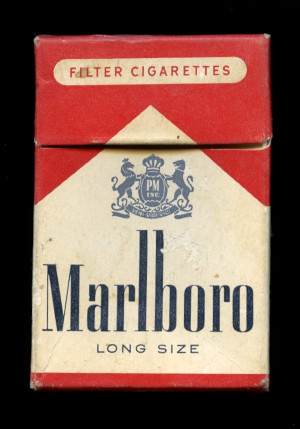
In the early 1960s, Philip Morris was a much smaller concern than it is today. Established market leaders, R J Reynolds and American Tobacco, had over 60% of the US cigarette market between them.
Philip Morris was a disrupter. They sponsored America's most popular TV show 'I Love Lucy' starring Lucille Ball. Philip Morris also used packaging innovations to get extra sales.
In the early 1950s, Philip Morris introduced a snap-open version of the traditional soft cup, which they heavily advertised.
Philip Morris' next move was to re-package their upmarket brand, Marlboro, which sold mainly to women smokers. It was to be a popular brand with strong masculine appeal. They re-designed the pack, putting Marlboro in a flip-top box instead of the traditional soft cup.
The box was a significant part of Marlboro's appeal. Other key factors were Leo Burnett's advertising, culminating in the famous cowboy adverts, the graphic design of the pack and Marlboro's new filter allied to the rise of filter cigarettes in America.
The importance of being first
Philip Morris gained by being the first maker to introduce a flip-top box. They retained that advantage over ten years later. These figures show that most flip-top boxes sold in USA in 1967 contained Philip Morris cigarettes.
| Company | Flip-top box sales (billions of cigarettes) |
|---|---|
| Philip Morris | 22.75 |
| Lorillard | 7.51 |
| R J Reynolds | 2.7 |
Source: Derived from figures published in 'The Maxwell Report (1968)' from the Tobacco Reporter, volume 95 No. 11, November 1968.
Lorillard's second place was down to Newport, the first menthol cigarette in a flip-top box, which they introduced in 1957.
Being the first with a new style of pack was key to dominating sales in that pack type. Would the same hold for plastic packs?
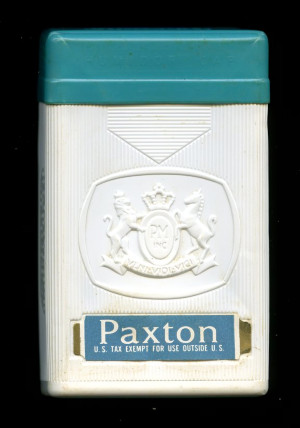
Why a plastic pack?
Today the idea of cigarettes in a single-use plastic pack is the most toxic combination you can imagine. But in the 1950s, plastic was a new material and plastic packaging was modern. According to Lloyd Stouffer, the Editor of Modern Packaging in 1963:
The happy day has arrived when nobody any longer considers the plastic package too good to throw away. [5]
When Philip Morris engineers conceived the idea of a plastic cigarette pack, there were few disposable plastic containers.
It could have been a new trend that would replace all existing packaging. Philip Morris would be the leaders with the plastic pack as well as the flip-top pack.
For any manufacturer a new plastic pack was a step into the unknown. It demanded huge research and development costs. It was high risk. The payoffs in improved shelf-life, customer convenience and cheaper manufacturing, might also be as high.
Plastic packaging for cigarettes had advantages over traditional paper and foil packs and flip-top packs. People carried cigarettes in a pocket or a handbag. A plastic pack kept their cigarettes safe from knocks and crushes. It also formed a new seal after they opened the pack and kept the cigarettes fresh. A plastic pack could also be water resistant, if not completely waterproof.
Most importantly, in a crowded market, the plastic pack would stand out on a shelf in a drug store or in a supermarket. Shoppers' keenness to try the new brand in Tulsa and Fresno proved that.
I have shown that being first with a flip-top box had a large and sustained advantage. So if plastic packs were popular, there would be a huge reward for being first.
Conception
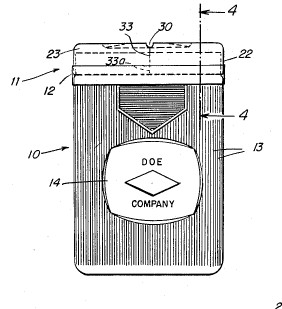
(image public domain, US Patent)
Development of the plastic cigarette pack at Philip Morris began in 1957. It was called 'Project Roper', possibly after Robert P Roper, Executive Vice President of Philip Morris.
Although the Marlboro flip-top box was successful, Philip Morris soon introduced a traditional soft cup alongside it. The main complaint about the flip-top box was the sharp edges. Men put cigarette packets in shirt pockets; the flip-top box was uncomfortable in the pocket. So the new plastic pack was to replace, not the flip-top box, but the soft cup.
They called the new pack a 'Humiflex' pack. Flex was an important part of the design.
The original aims were:
- remove sharp corners and edges;
- reduce the number of components in the pack;
- make a sealed pack to keep the cigarettes fresh after opening;
- remove the need for folding card to make manufacture simpler.
Source: Philip Morris Inc. Inter-office memo dated April 28, 1961, retrieved from Truth Tobacco Industry Documents
They also wanted to keep moisture in the pack and make the pack as waterproof as possible. Internal tests showed that the pack was waterproof. Philip Morris' advertising showed the pack in a bowl of water.
Philip Morris also believed, for economic reasons, that they needed to make the pack in-house. When the project started, they factored in a reduction in the cost of plastics. Existing prices would have made the pack too costly in 1957.[6] This gamble paid off; the cost of plastic came down in the 1960s and other forms of packaging became more expensive.
Philip Morris commissioned DeBell and Richardson to make the first test packs in 1959. In 1960 Fred Wiley and Clifford Goldsmith from Philip Morris filed a patent for the first version of a plastic cigarette pack. [7]
An important part of the design was that the pack was to be 'throwaway'. The material needed to be as thin as possible to reduce costs. The container had a ribbed surface to give it rigidity and strength. The final pack including the lid weighed 4g. The drawings for the patent application showed space for a logo and a name on the pack. [7] Philip Morris left the final design until later.
The new pack was made from extruded polystyrene, the solid form of polystyrene, not the foam which most people think of. In the 1950s polystyrene was already making an impact in the form of polystyrene cups and beakers.
Extruded polystyrene could be moulded with the application of heat. The packs were made from polystyrene sheets which were reformed under heat.
Philip Morris sourced an "R4" thermoforming machines from Formvac, Zurich, Switzerland [6] and new packing machines made by Molins, which were able to put cigarettes into the new packs and seal them.
The technical achievement, of the development of the packs and the machinery to make them and to pack the cigarettes, was colossal. As was Philip Morris' investment in plant and machinery. In 1962 Philip Morris' board approved a capital expenditure of $5.3m. [8]
They developed the pack on its own, without a decision about which cigarettes it would contain. This was a mistake as the cigarettes and the pack had little reason to be together.
Which cigarettes?
In February 1961 a memo from J E Lincoln, a future Philip Morris Vice President, discussed three alternatives for the plastic pack: a carbon (charcoal) filter cigarette, a cigarette with a compressed tobacco filter and a new menthol filter cigarette.
The compressed tobacco filter was quickly dropped. The other two alternatives were in market sectors where Philip Morris did not have a strong foothold.
By August 1962 Philip Morris' management decided on both a high-filtration menthol cigarette and a carbon filter cigarette for the new pack.
Menthol filter and carbon filter cigarettes were new innovations in the 1950s.
R J Reynold's Salem dominated the menthol filter sector. Philip Morris already tried to break into this market with Alpine. They spent huge sums on advertising but made little impression.
American Tobacco's Dual Filter Tareyton had the carbon filter market entirely to itself. A carbon or activated charcoal filter removed noxious gases from cigarette smoke, including hydrogen cyanide.
Activated charcoal filters sounded scientific and persuaded some to carry on smoking. In practice the benefits were dubious.
Prophetically, J E Lincoln thought that neither the cigarettes, nor the packaging, would be exciting enough to interest the public. [11]
The name for the new carbon brand was to be 'Saratoga' and 'Paxton' chosen for the menthol brand.
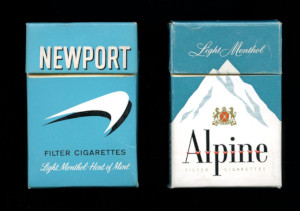
Design and color choice
Walter Landor styled the packs. He worked as a design consultant for Philip Morris through his own business Landor Associates. Landor had already designed Alpine and Benson & Hedges boxes for Philip Morris. Alpine incidentally bore a strong family resemble to Marlboro. Landor's design had worked a picture of a snow-covered mountain into the triangle of the Marlboro pack.
Landor's designs were white boxes with color-coded lids. He put a large, embossed Philip Morris crest on both sides. Previous tests showed that the crest had associations of high quality and superiority. [12]
Saratoga
Saratoga is a county in New York State. Philip Morris' HQ was in New York.
Saratoga had a white pack with a red lid. Other filter brands such as Marlboro, Winston and L & M used these colors. They signalled a full flavor filter cigarette to the customer.
Paxton
It is possible that that name came from Rev John R. Paxton. Rev Paxton was a Private in the Pennsylvania Volunteers fighting on the Union side. Paxton wrote an article for Harpers Weekly in which he recalled that Confederate and Union troops met to swap coffee from the North with tobacco from the South. Tobacco News reprinted the article in the June 1961. The date of the reproduction was right for Philip Morris employees looking for a new brand name to have stumbled across it.
Paxton had a turquoise lid, echoing the color of other menthol brands.
Philip Morris used the name 'Humiflex' to describe the new pack. They called the cap on the early packs a 'humidor' cap. It was not the first time that this word was used in cigarette packaging. In the 1930s R J Reynold's adverts encouraged customers not to remove the wrapping from a pack of Camels. They reasoned it would keep the cigarettes fresh. The adverts illustrated a transparent 'Humidor Pack'. A humidor is a container for expensive cigars, so it lent an upmarket feel to cheaper cigarettes.
Both these cigarette brands, despite the upmarket imagery and high-tech filters, were to be sold at popular prices. That meant around 30c per pack. Very few cigarettes would sustain higher than average prices in the 1960s. Premium-priced cigarettes were a tiny market in 1960s America.
How successful was the plastic pack?
The plastic pack was well-received by the plastics and the packaging industries.
The brilliant star on the US scene is the Philip Morris polystyrene pack for its new Paxton and Saratoga cigarettes [5]
The package as used for the company's new Paxton brand has been regarded by many as one of the most significant packaging developments of recent years. [6]
Customers loved the plastic pack. In a 1964 survey by the pollster, Elmo Roper for Philip Morris, studied what smokers thought of the plastic Paxton pack. In a sample of 1,000 smokers, 57% preferred the plastic pack to a hinged-lid (flip-top) or soft cup pack. The top two reasons were that it kept the cigarettes safe and it looked better. Some thought it could be re-used as a substitute cigarette case. The plastic pack was more attractive to women than men, but 50% of the men in the survey still rated it. [9]
Roper's survey found the plastic pack superior to both the soft pack and the flip-top box. He thought it achieved Philip Morris' objective of replacing the soft cup without the drawbacks of the flip-top box. Smokers who preferred a soft cup thought it was more like the cup and smokers with a liking for the flip-top box thought it was like their preferred option. Most thought that the plastic pack was better.
The biggest negative was the detachable top. Smokers had a technique for getting a cigarette out of open soft pack with one hand. This came in handy when driving.
Marketers at Philip Morris responded by suggesting that people threw the lid away or fitted it to the bottom of the pack. Engineers responded by giving the plastic pack a hinged lid in 1967.
Some soft pack fans found it too bulky for a shirt pocket, a common complaint of the flip-top box.
Elmo Roper further probed the plastic pack's appeal in relation to other factors. His view was that the pack performed very well but was just an 'attention grabber'. Packaging was not a major factor in brand choice. Flavor, mildness and lack of irritation were much more important to smokers. Even Paxton smokers thought that the pack was only the fifth most important factor in choosing the brand; it was number twelve for other smokers.
After Archie Sugg's initial survey, R J Reynolds examined the pack again. Reynolds recognized its shelf appeal. They saw the benefits too: it kept the cigarettes in better condition. They also disliked the cap. Reynolds guessed the size of Philip Morris' investment in plant and shied away from following them.
Despite the positive reception for the pack, Philip Morris' launch of two new brands, Paxton and Saratoga, was a flop. Paxton, the menthol cigarette, lasted two years despite an expensive advertising campaign. Saratoga never made it out of test marketing.
In a test market in Denver, few smokers claimed to have heard of Saratoga. Those that had tried it did not like it. It was too mild and had no flavor. Some expected it to have a menthol taste, confusing it with Paxton. Paxton did better than Saratoga. Philip Morris marketed it throughout the US and internationally.
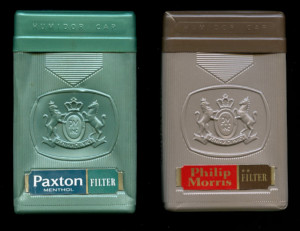
Another try...
With the investment in the plastic packs already made, Philip Morris did not want to write it off just yet. They tried again with new brands and new color schemes.
In 1964, Philip Morris put their own name on the plastic pack and swapped Saratoga for Philip Morris Multifilter. There were two filters, a carbon inner filter and a cellulose outer filter.
The Multifilter pack was two-tone brown, perhaps the inspiration was the original 1933 design for Philip Morris. Engineers mixed metallic pigments to get the color. They also considered a gold-colored pack.
Test markets in 1963 showed that Multifilter had stronger customer appeal than Saratoga. Some comments from the Portland test are telling:
The Philip Morris filter in Portland...is getting good trying. The surprising thing is that this trying is also in carton sales. (It was tried in a soft cup as well) I would attribute this to only one thing, the brand name. It is not the package because the package is not doing it on Saratoga. It is not the advertising...the cigarette itself is well liked. [10]Packaging novelty could not sell a bad cigarette; Saratoga proved this. Multifilter would have done well enough without the plastic pack. But Philip Morris had spent the money.
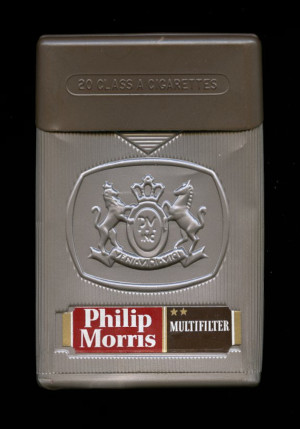
Philip Morris invested heavily in the color scheme for the new pack. They hired Louis Cheskin of LCA Marketing Research to analyse consumer reaction to colors of the pack and the labelling in 1965 and in 1966. The 1965 test showed that a brown pack with a brown label beat both a gold pack and brown pack with a red and brown label. The second test showed that gold lettering was no longer appealing and white lettering, as shown on the 1967 flip-top pack was better.
The first adverts talked about Multifilter being the 1970 cigarette. Both the filter and the pack were high-tech. They compared it to a futuristic '1970 house' and '1970 car'. Multifilter was the '1970 cigarette', but unlike the house and the car, you could have it in 1964.
Another advertising campaign in 1964 touted the benefits of coconut shell charcoal, which Philip Morris used for Multifilter. Although this sounded scientific, it was not unique in the industry.
Multifilter achieved third place behind Tareyton and Lark in the carbon filter market. Not a disaster, but not a huge success either.
The cigarette industry's advertising code slowed Multifilter's progress. The new code restricted descriptions of filters. Philip Morris renamed Multifilter to 'Philip Morris Filter' in 1965 and they suspended advertising in 1966. They also and did not shout about the new flip-top pack, introduced in 1967. They only advertised it in export markets.
The restrictions on advertising the properties of filters ended by voluntary agreement in 1968.
Elmo Roper also said that the Paxton filter was not interesting enough, and the carbon filters were the new trend.
Paxton got a new box in two-tone green in around 1965. In 1966, Philip Morris dropped the Paxton name. The replacement, also in the two-tone green pack, was Philip Morris Menthol which also had the multifilter charcoal filter.
Try again...
For 1970 Philip Morris returned to the Multifilter name and replaced both the brown and green packs with a new ivory one.[13] Lighter colors signalled milder cigarettes. Philip Morris had already introduced improvements to the filter in both cigarettes which lowered tar and nicotine.
The new pack had a wrap-around label with two circles representing the two filters which gave it a 'scientific' look. The advertising showed a diagram of the new filter, but did not make much the plastic pack.
Consumer tests in 1971 still showed that the public preferred the new plastic packs to traditional soft packs. [14]
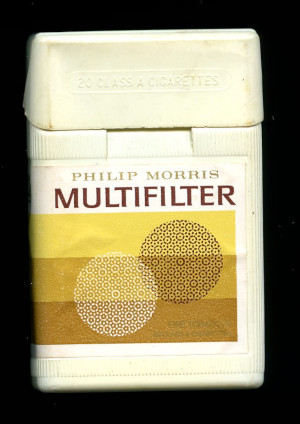
By 1972, in the US market only, Philip Morris changed the brand name again, this time to 'Benson and Hedges Multifilter'. The adverts called it 'the moderate smoke' and targeted middle-aged customers. This did not seem a good message to go with the futuristic plastic packaging.
Neither the new pack nor the Benson and Hedges name helped.
The numbers
How much did the plastic pack really cost? Did it make a profit for Philip Morris?
Although Philip Morris claimed the costs were similar, the Humiflex pack was more expensive to make than both the flip-top box and the soft cup. The cost of the packaging for the Humiflex pack worked out at nearly 82c per 1,000 cigarettes, as opposed to 40c for the Marlboro flip-top box and 32c for the soft pack.
The cigarettes were also expensive. Carbon filters which were used in both the menthol and non-menthol cigarettes were expensive to make. They sold for the same price as regular cigarettes, so this meant a lower profit margin.
New brands needed an advertising boost. Philip Morris spent more on advertising than they had spent on plant and machinery.
In the first two years the new packs lost Philip Morris $7m on top of what they had spent on plant. They recovered this with scaled-back advertising and re-branding in later years. Overall, Philip Morris made a modest profit out of these cigarettes in the 1960s.
Why did the plastic pack fail?
Plastic replaced card, paper, glass and metal packaging for many products by the end of the 1970s. Why did this not happen for cigarettes?
There is no doubt that the plastic pack performed well and offered numerous advantages over both the flip-top box and the soft cup. But it never came close to replacing them.
The main reason was that packaging was not an important reason for choosing a cigarette brand. It was well down the list of factors smokers considered. Once someone had chosen a particular brand, it became their cigarette. It was hard to get them to switch brands. A new brand in a new pack was never going to do it without other compelling reasons to change brand.
The first to market a new type of cigarette had a big advantage. [15] Salem was the first menthol filter and Dual Filter Tareyton, the first charcoal filter. Philip Morris executives might have thought that the plastic pack's USP would overcome this advantage. After all the flip-top pack worked for Marlboro.
The circumstances of Marlboro's launch were different. When Philip Morris launched Marlboro in 1954 there was great disruption in the cigarette market. Many smokers tried filter cigarettes for the first time. They tried Marlboro, Winston, Kent, Viceroy and L & M. A large minority liked the flip-top box. Only Marlboro had this box. People had no strong brand allegiances. The flip-top box was a factor in creating a strong allegiance to Marlboro. Marlboro in the flip-top box outsold Marlboro in the soft cup a decade later; for other brands it was the reverse.
When Philip Morris launched the plastic pack, it did not contain a new type of cigarette. Brand loyalties were established for the leading menthol filter and charcoal filter brands. Smokers of these cigarettes did not adopt Paxton or Multifilter, even though, most thought that Paxton's pack was superior.
Ultimately, a new pack, no matter how good, was not enough to get smokers to change brands. Even though most were not able to pick out their own brand from similar style competitors without seeing the box.
To make plastic packaging work for cigarettes a manunfacturer would have to put a top-selling existing brand in a plastic pack or launch a new brand with strong reasons for smokers to switch.
Having failed to establish enough market share for the plastic pack, its survival was doubtful.
The end of the plastic pack
As early as 1976 there was concern in the tobacco industry about the biodegradability of packaging and the environment. Speaking in 1991, Walter Landor thought that the plastic pack came to market too late. It was not established before people raised environmental concerns. [16]
Unlike the flip-top box, Philip Morris patented the plastic pack . Yet other manufacturers could have designed their own packs. None did after seeing Philip Morris' experience. The plastic pack never had a chance to become accepted in the way the flip-top box had. This was good news for the environment.
Empty cigarette packs were often discarded. In 1956 Lloyd Stoffer said that "the future of plastics is in the trash can". For the cigarette packet, the future of plastics might have been on the sidewalk, or on the roadside, chucked out of a passing car window. At least the carboard packs rotted. The plastic ones did not. The website 'Rubbish Walks' has a picture of a long discarded Multifilter pack recently re-discovered. It is damaged, but most of the plastic remains. See Philip Morris plastic cigarette pack.
Had the plastic pack really taken off, it would have contributed to plastic waste. Did tobacco firms need another reason to be the bad guys?
What killed the plastic pack in the end was not environmental worries, but the oil crisis of 1973.
Petroleum shortages led Philip Morris to drop plastic packs in the US in 1974. The change had no impact on sales. Plastic packs continued in Europe for another three years until 1977. In Europe, the ivory Multifilter pack replaced the brown one in 1974. [17]
Surveys consistently reported that customers preferred the plastic packs and Philip Morris sold more of the plastic packaged Multifilter than conventional packs with the same graphics. But when Philip Morris dropped plastic packs, no-one noticed.
Twenty years after research on plastic cigarette packets had started, they had disappeared almost without trace.
In conclusion
Unlike other forms of plastic packaging, plastic cigarette packets were not a success. They might have been terrible for the environment had they been.
At the time, the packaging industry praised the new pack and competitors feared it. It grabbed smokers' attention but did not disrupt the cigarette market.
The plastic pack was not a reason on its own to buy a new brand, only to try it. It was not enough for Philip Morris to dislodge established rival. In the 1960s plastic packs were more expensive than conventional packaging. So there was no advantage to the manufacturer.
Philip Morris' gamble failed. They could have probably done as well with traditional packaging for both Multifilter and for Paxton.
Plastic packaging never returned to the cigarette industry to any large extent.
PS The Soviet connection
From the mid-1960s American tobacco companies exported limited quantities of American cigarettes to the Soviet Union. They sold them to international hotels and hard currency stores often at prices well in excess of locally-produced cigarettes. [18]
Multifilter was a favourite duty-free cigarette. A price list from Belgrade Airport listed several American cigarettes, including Multifilter.
Philip Morris, Switzerland, made the new flip-top plastic pack. They promoted it in European markets including Finland. Finland may have provided a route into the USSR.
American cigarettes were a fascination to Eastern Europeans. Such an allure applied to other products like American-made jeans and Coca-Cola too.
On a Russian web site, the author described how his uncle gave him a pack of Philip Morris Multifilter in the 1970s. They were a luxury item, only available to the top of Soviet society. Russians prized the plastic packs and kept them after they had smoked the cigarettes. They could have put cheaper Russian cigarettes into the pack once the Philip Morris ones were gone.
References
[1] Discussed in several documents retrieved from Truth Tobacco Industry Documents
[2] 'THE PAXTON PACKAGE Consumer Research In Fresno, California and Tulsa, Oklahoma', a report by William Esty and Co for R J Reynolds, September 1963
[3] Memo for W A Sugg to W S Smith (Philip Morris Vice President) about the Paxton trial in Tulsa and Fresno, retrieved from Truth Tobacco Industry Documents
[4] 'The Maxwell Report (1968)' from the Tobacco Reporter, volume 95 No. 11, November 1968
[5] 'Plastics and Packaging Today and Tomorrow' by Lloyd Stouffer, report presented at the SPI Annual National Plastics Conference at the Sheraton-Chicago Hotel, Chicago, Illinois.
[6] 'The Paxton Story: Now it can be told' published in 'The Complete Authority of Packaging', June 1964, Volume 37, Number 10, page 93.
[7] US Patent No 3,167, 104 filed by F E Wiley et al, July 27, 1960, granted Jan 26, 1965.
[8] 'Minutes of a meeting of the Board of Directors of Philip Morris' on August 29, 1962, retrieved from Truth Tobacco Industry Documents
[9] 'A study of awareness and attitudes towards Paxton cigarettes' by Elmo Roper and Associates, January 1964, retrieved from Truth Tobacco Industry Documents
[10] 'Internal memo from Alan H. Bick' dated November 4, 1963, retrieved from Truth Tobacco Industry Documents
[11] Memo by J E Lincoln dated February 1, 1961, retrieved from Truth Tobacco Industry Documents
[12] 'Secrets or Marketing Success' by Louis Cheskin, published by Trident Press, New York in 1967, page 137.
[13] Philip Morris Circular No 390, December 31, 1969,, retrieved from Truth Tobacco Industry Documents
[14] Internal memo dated October 18, 1971 - Multifilter test markets,, retrieved from Truth Tobacco Industry Documents
[15] 'Brand Performance in the Cigarette Industry and the Advantage to Early Entry, 1913-74' by Ira Taylor Whitten
[17] 'Mini biography of Walter Landor', retrieved from Truth Tobacco Industry Documents
[17] 'Materials Department, Philip Morris, Europe' January 1974, retrieved from Truth Tobacco Industry Documents
[18] 'Life-course Smoking Behavior Patterns and National Context in Ten Countries' by Dean Reginald Lillard, Rebekka Christopoulou, published by Oxford University Press in 2015, page 255.
By Steven Braggs, December 2023


Comments